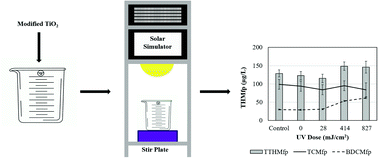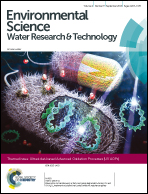Solar photocatalysis with modified TiO2 photocatalysts: effects on NOM and disinfection byproduct formation potential†
Abstract
Solar photocatalysis with titanium dioxide (solar/TiO2) is an advanced oxidation process (AOP) for drinking water treatment that has the potential to provide concurrent disinfection and contaminant degradation with minimal energy input. In this study, a suite of photocatalytic TiO2 nanomaterials modified with nitrogen, boron, or silver to improve their performance under solar irradiation were evaluated for use in solar drinking water treatment applications. The effect of solar/TiO2 treatment with each material on natural organic matter (NOM) in synthetic and real river water was determined by tracking the change in dissolved organic carbon (DOC) and UV absorbance at 254 nm (UV254) over a range of irradiation times comparable to solar/TiO2 disinfection studies. The samples were subsequently chlorinated and the concentrations of trihalomethanes (THMs) and haloacetic acids (HAAs), two commonly regulated disinfection byproducts (DBPs), were measured. In almost all cases, the DBP formation potential (DBPfp) of both water sources decreased due to NOM's adsorption on the TiO2 nanomaterials. However, DBPfp increased upon simulated solar irradiation at low UV doses before decreasing upon further solar irradiation to provide higher UV doses. Additionally, changes in SUVA, THMfp/DOC, and HAAfp/DOC indicate that the overall reactivity of the NOM towards chlorine was increased by solar/TiO2 treatment. The results of this study suggest that small but significant increases in DBPfp are likely to occur at TiO2 and UV doses typically used in solar/TiO2 disinfection studies. The results also suggest that modifications made to nanomaterials to improve their performance in solar applications can have unexpected impacts on their chemical and physical properties that hinder their treatment efficacy.

- This article is part of the themed collection: Ultraviolet-based Advanced Oxidation Processes (UV AOPs)


 Please wait while we load your content...
Please wait while we load your content...